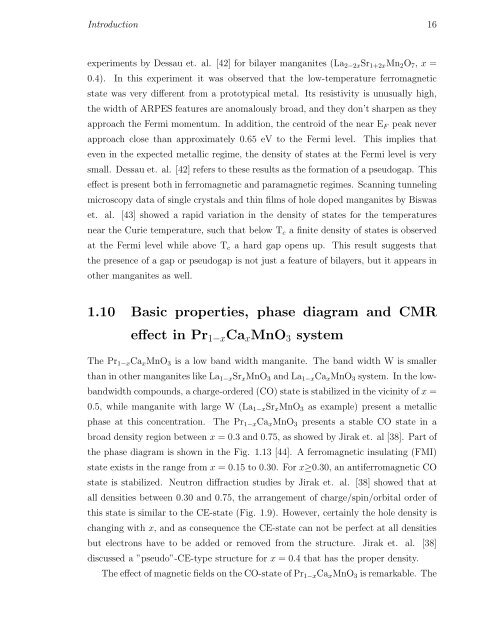PHYS07200604007 Manas Kumar Dala - Homi Bhabha National ...
PHYS07200604007 Manas Kumar Dala - Homi Bhabha National ...
PHYS07200604007 Manas Kumar Dala - Homi Bhabha National ...
You also want an ePaper? Increase the reach of your titles
YUMPU automatically turns print PDFs into web optimized ePapers that Google loves.
Introduction 16<br />
experiments by Dessau et. al. [42] for bilayer manganites (La 2−2x Sr 1+2x Mn 2 O 7 , x =<br />
0.4). In this experiment it was observed that the low-temperature ferromagnetic<br />
state was very different from a prototypical metal. Its resistivity is unusually high,<br />
the width of ARPES features are anomalously broad, and they don’t sharpen as they<br />
approach the Fermi momentum. In addition, the centroid of the near E F peak never<br />
approach close than approximately 0.65 eV to the Fermi level. This implies that<br />
even in the expected metallic regime, the density of states at the Fermi level is very<br />
small. Dessau et. al. [42] refers to these results as the formation of a pseudogap. This<br />
effect is present both in ferromagnetic and paramagnetic regimes. Scanning tunneling<br />
microscopy data of single crystals and thin films of hole doped manganites by Biswas<br />
et. al. [43] showed a rapid variation in the density of states for the temperatures<br />
near the Curie temperature, such that below T c a finite density of states is observed<br />
at the Fermi level while above T c a hard gap opens up. This result suggests that<br />
the presence of a gap or pseudogap is not just a feature of bilayers, but it appears in<br />
other manganites as well.<br />
1.10 Basic properties, phase diagram and CMR<br />
effect in Pr 1−x Ca x MnO 3 system<br />
The Pr 1−x Ca x MnO 3 is a low band width manganite. The band width W is smaller<br />
than in other manganites like La 1−x Sr x MnO 3 and La 1−x Ca x MnO 3 system. In the lowbandwidth<br />
compounds, a charge-ordered (CO) state is stabilized in the vicinity of x =<br />
0.5, while manganite with large W (La 1−x Sr x MnO 3 as example) present a metallic<br />
phase at this concentration. The Pr 1−x Ca x MnO 3 presents a stable CO state in a<br />
broad density region between x = 0.3 and 0.75, as showed by Jirak et. al [38]. Part of<br />
the phase diagram is shown in the Fig. 1.13 [44]. A ferromagnetic insulating (FMI)<br />
state exists in the range from x = 0.15 to 0.30. For x≥0.30, an antiferromagnetic CO<br />
state is stabilized. Neutron diffraction studies by Jirak et. al. [38] showed that at<br />
all densities between 0.30 and 0.75, the arrangement of charge/spin/orbital order of<br />
this state is similar to the CE-state (Fig. 1.9). However, certainly the hole density is<br />
changing with x, and as consequence the CE-state can not be perfect at all densities<br />
but electrons have to be added or removed from the structure. Jirak et. al. [38]<br />
discussed a ”pseudo”-CE-type structure for x = 0.4 that has the proper density.<br />
The effect of magnetic fields on the CO-state of Pr 1−x Ca x MnO 3 is remarkable. The
















